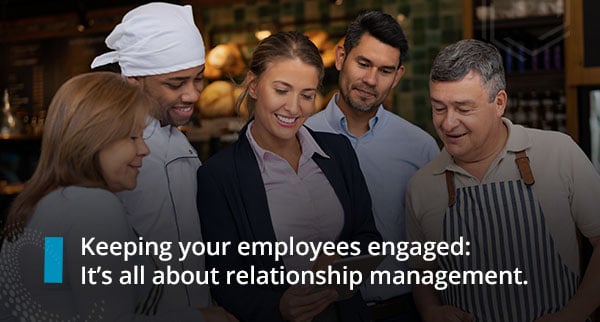Look at any hotelier’s website right now, and you’ll find one commonality: Lots of open positions. As the hospitality industry works to recover from the pandemic, their workers are waving goodbye to their old jobs in search of something better — 4.4 million Americans quit their jobs in September, the highest number ever recorded.
According to data from the Bureau of Labor Statistics, the average worker in leisure and hospitality is taking home $417 each week right now — a more than $50 increase since the same time last year. Initiatives, such as signing bonuses, are being offered. So, if earnings are increasing, why is every hotel still short on staff?
There’s no question that increasing a salary is an important start to attracting workers, but the payoff of an increase in salary only lasts for a limited amount of time. Keeping your employees engaged has never been more important – and a constant focus moving forward. What are some other factors that keep people engaged? Better work hours? A better opportunity to balance work and personal life? What about better tools to make a job easier? Think about cleaning a hotel room. By and large, it is cleaned the same way today as it always has been — pushing an oversized cart down a long hallway. We all need to ask ourselves a simple question: What are we doing to make the job better for every employee?
Ways to improve
We are at a crossroads in the industry. Companies can no longer have an employer-first mindset. Instead, they need to create unique value propositions for each group of employees. The definition of a good employment opportunity for a Gen Z employee with no kids and no car is different from a Gen X employee who is trying to support a family. And what about retirees? Many baby boomers still want to work. They might be happy to be a host or a greeter in the lobby, but they are not looking to work 40 hours each week. Regardless of the generation, it’s time to rethink shift lengths. Would employees prefer to work four 10-hour days and get three full days off? For employees paying for childcare or burning loads of hours in transit to and from work, that extra day off means saving time and money. In Iceland, a test of a four-day work week was successful, leading to more happiness and more productivity. To offer flexibility that fits the modern employee’s needs it is critical to refine your scheduling technology to keep up with the complexity that multiple start times and shift lengths brings.
How can the guest experience relate to employee engagement?
Think about the average housekeeper, dishwasher, or banquet server. Why not offer employees loyalty points the same way we give them to guests? The benefit here is two-fold. First, employees receive another valuable benefit with the chance to take a vacation of their own. Second, if an employee can feel the magic of what the guest feels, he or she can become more engaged in their role in shaping that experience.
Find what motivates your staff. Maybe it is a gift card to the local grocery store or put them first in line to be scheduled for their ideal shifts. With gamification, a work environment that rewards the behaviors you’re looking for go a long way. Employees can earn points and be rewarded for showing up for shifts, on time clock ins, and other actions you would like to see from your staff.
But where do we start?
Before you implement loyalty and engagement tactics that you think will appeal to your employees, you have to think about a more essential element: The relationship between employees and an employer. This isn’t simply about task management or productivity management. It’s about relationship management. Why should they work for you?
To answer that question, the first step is simple: Ask them. “There is an imbalanced focus on the first 90 days of a new hire’s experience, and then, another survey doesn’t arrive for a year. We need to be proactive and ask for feedback more regularly. It’s one of the reasons why we’re focused on helping hotels offer pulse surveys to gather immediate, real-time insights,” says Heymann.
The relationship between staff and guest experience
As we rethink the employee experience, we must think about the guest experience too. Within the next few years, there will be very lightly staffed front desks. Everyone will use their smartphones to get into their rooms. Take a look at the airline industry. Passengers can pick seat 12D on their flight tomorrow to New York. Soon enough, depending on the segment of hotel they’re staying in, guests will expect to be able to pick their specific room, too. Technology will change staffing needs — not eliminate them. And to drive the meaningful experiences that drive loyalty and revenue, staff can be reallocated to focus on delighting guests and letting technology either automate certain functions or optimize staff productivity.
Think about the business traveler checking into a four-star hotel today — only to find out that the restaurant isn’t open, or room service isn’t running. The person paying a full-service rate will expect food and beverage services. This isn’t just about lost revenue opportunities for the hotel. The problem is bigger – loyalty and segmentation are at stake. If the hotel can’t meet these expectations because of staffing issues, will potential guests start booking at a different hotel? Will they opt for a mid-market limited-service property and walk down the street for dinner?
Recently Marriott announced they are requiring all franchise owners to open their food and beverage operations – no matter what. This is going to require managers to be creative with the staff they have and double down on their own employer brand to keep their current employees and find new staff. To keep ADR and occupancy rates high, hoteliers must prioritize both the employee and guest experiences.
To win in today's market, hoteliers must rethink the operational structures that have not evolved much from 50 years ago. In today’s service-driven economy, and the current labor crisis, the old models just aren’t working. It’s time to think about one big question that must be answered: How as an industry, how do we stay relevant as employers? ⬡






